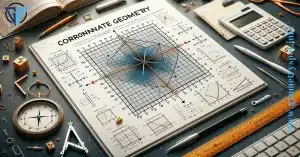What Is Coordinate Geometry? Unraveling the Fabric of Space and Numbers

Once upon a time, in a realm of numbers and spaces, a method emerged that would bridge the gap between algebra and geometry, giving birth to what we know today as coordinate geometry. But what exactly is this mathematical sorcery that allows us to map the stars, design intricate buildings, and even navigate the digital worlds of computer graphics?
At its core, coordinate geometry, also known as analytic geometry, is the study of geometric figures through the use of a coordinate system. This means that instead of relying on just a ruler and compass, it uses algebraic equations to represent geometric shapes. It’s a bit like having a secret decoder ring that translates geometric shapes into algebraic expressions and vice versa.
Understanding the Coordinate Plane
Imagine you’re the captain of a ship in the vast ocean of mathematics. Your trusty map? The Cartesian plane. Here, every point is marked by two numbers, its coordinates, like a treasure map leading to the spot marked ‘X.’ This map has two axes, horizontal and vertical, dividing it into four quadrants, each with its own personality. It’s in this space that the adventure of plotting points and navigating the sea of geometry begins.
The Significance of Coordinates
Coordinates are like the DNA of the coordinate plane. They tell us the exact location of a point, akin to a street address in the grid-like layout of a bustling city. By learning how to plot these points and read their coordinates, we unlock the ability to describe any location in this two-dimensional world with just a pair of numbers. It’s a little bit like magic but based on pure, logical reasoning.
Linear Equations and Slopes
Moving on, let’s talk about the slopes. They’re not just for skiers! In coordinate geometry, the slope of a line tells us how steep it is. Imagine walking up a hill—the steeper the hill, the higher the slope number. And just as you can predict the effort needed to climb a hill by looking at its slope, you can predict the behavior of a line in coordinate geometry by its slope value.
The Graphical Method: Plotting and Solving
Plotting lines and curves on the coordinate plane can feel a bit like painting by numbers. You take the equation, find the points that make it true, and plot them to reveal a picture, which in this case is the graph of the equation. And when you’re solving equations graphically, it’s like finding where two lines of a story intersect, telling us a tale of where two mathematical expressions meet.
Distance and Midpoint Formulas
Have you ever wondered how far apart two points are or what’s the middle point between them? Well, coordinate geometry has got you covered with the distance and midpoint formulas. It’s like having a mathematical ruler and compass built right into the system. You can measure the distance between two points as if they were cities on a map and find their midpoint as if you were looking for the perfect spot to meet a friend for lunch.
The Geometry of Lines in Coordinate Geometry

In the landscape of coordinate geometry, lines can either be parallel, like railroad tracks never meeting, or perpendicular, crossing each other at a perfect 90-degree angle. Understanding these properties is essential for interpreting graphs and predicting how lines will behave, which is crucial, whether you’re designing a building or just solving a math problem.
Curves and Non-Linear Geometry
But the world isn’t just straight lines; it’s full of curves and bends. In coordinate geometry, we explore these through quadratic equations and other non-linear forms, creating a variety of curves like parabolas that mirror the arc of a ball thrown in the air, ellipses that resemble stretched-out circles, and hyperbolas that look like two opposing arcs.
Geometry Spot: Unlocking Geometric Concepts - Explore angles, shapes, and symmetry. Learn how to calculate area, perimeter, and more.
Circles in Coordinate Geometry
Speaking of circles, they have a special place in coordinate geometry. Defined by a simple equation, circles can be mapped onto the plane, revealing all the hidden relationships and properties that come with this round figure. It’s a bit like discovering a secret society with its own set of rules and codes.
Applications of Coordinate Geometry in Real Life
You might be wondering, “Is all this just theoretical?” Not at all! Coordinate geometry is like the silent hero behind many everyday technologies, from the GPS systems that guide us to our destinations to the computer graphics that make video games and movies come to life.
Transformations in the Coordinate Plane
Transformations are the dance moves of geometry. Points and shapes can slide (translate), turn (rotate), grow or shrink (scale), and even flip (reflect) across the plane. Each move changes the position or size of a shape, and understanding these transformations is like learning the choreography to a geometric ballet.
Coordinate Geometry in Advanced Mathematics
As we delve deeper, coordinate geometry takes us into the realm of calculus and beyond. It’s like opening a door to a room you’ve never explored in your house, filled with concepts like derivatives and integrals that describe how shapes change and move, bringing us to the brink of three-dimensional geometry.
Analyzing the Slope-Intercept Form
Back to basics, the slope-intercept form of a line, �=��+�y=mx+b, is a favorite in coordinate geometry. It tells us straight away the slope of a line and where it intercepts the y-axis. It’s as straightforward as reading a sentence and understanding the plot of a story from the first line.
Systems of Equations and Inequalities: A Pictorial Solution
When you’ve got more than one equation on your plate, it’s like trying to juggle apples and oranges at the same time — tricky, but doable with the right technique. Graphically solving these systems is all about drawing the lines or curves that each equation represents and looking for the points where they say “Howdy!” to each other. Those points of intersection are the solutions that satisfy all equations in the system.
But what about inequalities? These are less like lines and more like shaded regions on the graph. It’s as if the lines have put on their party dresses — colorful regions on the plane. When you’re dealing with inequalities, you’re not just looking for where they meet, but where they throw their joint party on the graph. It’s the overlap of these shindigs that gives us the solution set.
Triangles and Coordinate Geometry: Mapping Out the Shapes
Triangles are the gossipers of the geometric world; they always have something to say about the space they occupy, whether it’s about their area or their perimeter. To figure out a triangle’s area on the coordinate plane, you just need its base and height, and you’re set to calculate. As for the perimeter, it’s a simple matter of summing up all the sides — think of it as taking a walk around the triangle and measuring your steps.
Now, for congruency and similarity, that’s when triangles are like twins or family members. They either have the exact same measurements (congruent) or the same shape but different sizes (similar). And the cool thing about coordinate geometry is that it lets you prove this relationship using just the coordinates — no physical measuring required!
Polygons and Their Coordinates: The Many-Sided Story
When it comes to polygons — shapes with many sides — mapping them on the plane is a bit like connecting the dots. Each vertex (corner) has a coordinate, and you draw straight lines to connect these dots and reveal the polygon. And just like people, polygons have different properties that make them unique, which you can decipher from these coordinates, like the lengths of their sides and the measures of their angles.
The Conic Sections: A Deeper Dive into Curvy Geometry
Conic sections are the celebrities of coordinate geometry — curves formed by slicing a cone in different ways. You’ve got circles, ellipses, parabolas, and hyperbolas. Each has its spotlight in the geometric world and its own set of elements — like directrices, foci, and axes — that define its unique shape and position on the plane.
Circles are your straightforward conics, symmetrical and smooth. Ellipses are circles that wanted to stretch out a bit, with two foci instead of one. Parabolas are the paths of projectiles, always ready to catch a falling object with their open arms. And hyperbolas are like mirror-image arcs, never quite meeting but always part of the same curve.
Diving into these conic sections is like exploring different personalities. By studying their equations and properties, you can predict their behaviors and understand their unique ways of carving out space on the plane.
How Coordinate Geometry Shapes Our World: A Geometric Foundation
Picture a world where buildings rise on solid foundations and machines operate with precision. That’s where coordinate geometry shines — it’s the silent hero that shapes our concrete jungles and the digital landscapes we navigate through. In the realms of engineering and science, coordinate geometry is a foundational pillar. It allows architects to dream up structures that touch the sky and engineers to craft intricate parts that fit together like pieces of a cosmic puzzle.
Innovations Inspired by Coordinate Geometry: The Blueprint of Progress
Innovation is a fancy word for a simple idea: seeing what everyone has seen, and thinking what no one has thought. Coordinate geometry has been that fresh lens, inspiring innovations from the GPS systems that guide us to the computer chips that power our lives. It’s the language that has transformed the abstract into the tangible, turning wild ideas into groundbreaking technologies.
Challenges and Problem-Solving in Coordinate Geometry: Navigating the Maze
Coordinate geometry isn’t always a walk in the park. Sometimes, it feels like a maze with hidden traps. Students often hit walls — finding the intersection of complex curves can be as daunting as deciphering an ancient code. But it’s in these challenges that problem-solving thrives, propelling learners to develop strategies that peel back the layers of complexity and reveal the elegant solutions beneath.
Common Challenges Students Face: The Struggle is Real
Ask any student, and they’ll tell you: coordinate geometry can be tough. It’s not just about understanding concepts; it’s about visualizing them in a space that exists only in our minds and on paper. Finding the distance between points or the slope of a line can sometimes feel like trying to grab a cloud — you know it’s there, but it’s not easily grasped.
Strategies for Problem-Solving: The Coordinate Game Plan
The key to conquering the challenges of coordinate geometry? A solid game plan. Strategies like breaking problems down into smaller steps, using graphs to visualize equations, and approaching problems from different angles can turn a daunting equation into a solved one. Think of these strategies as your compass in the wilderness of numbers and variables.
Coordinate Geometry and Computer Graphics: Painting with Numbers
Computer graphics are like modern magic, conjuring images out of thin air — or rather, out of coordinates and geometry. Coordinate geometry plays the role of an artist here, guiding the virtual brush to create stunning visuals, from the simplest of games to the most complex simulations. It’s a dance of algorithms and equations that brings pixels to life.
The Role of Coordinate Geometry in Rendering: Behind the Digital Scenes
In the theater of computer graphics, coordinate geometry is the director, orchestrating every scene that unfolds on the digital canvas. It’s the math behind the 3D models and environments, turning lines and shapes into rendered beauty. Every frame in a movie or a game is a testament to how coordinate geometry can paint worlds with the stroke of an algorithm.
Algorithms and Coordinate Geometry: The Code That Binds
Behind every smooth animation and every realistic texture, there’s an algorithm working tirelessly, hand in hand with coordinate geometry. These algorithms are the unsung heroes, the code wizards that turn geometric instructions into visual spectacles. They’re not just lines of code; they’re the DNA of digital imagery.
Proofs in Coordinate Geometry: The Logic of Space
Mathematical proofs in coordinate geometry are like Sherlock Holmes solving a case — they require logic, reason, and a fair share of “Aha!” moments. Constructing geometric proofs is about connecting the dots, tracing the path from what you know to what you need to prove, and making sure that every step is as solid as the ground beneath your feet.
Constructing Geometric Proofs on the Plane: The Art of Argument
Proofs in coordinate geometry are more than just exercises; they’re intellectual art. Each proof is a story, beginning with assumptions, weaving through theorems and postulates, and ending with a conclusion that’s as satisfying as the last page of a good book. Constructing these proofs is like laying bricks to build a pathway to understanding.
Logic and Reasoning in Coordinate Proofs: The Blueprint of Truth
The beauty of logic and reasoning in coordinate geometry proofs is that they build a structure of truth, one logical step at a time. These proofs are meticulous blueprints that lay out the why and how of geometric principles, leaving no stone unturned in the quest for mathematical truth.
The Future of Coordinate Geometry: Charting the Unseen Horizons
As we gaze into the future, the prospects of coordinate geometry are as boundless as the universe itself. Emerging trends point to a world where geometry and technology converge more seamlessly than ever, crafting realities that once lived only in the realms of imagination.
Emerging Trends in Coordinate Geometry: The Shape of Tomorrow
The future is a mysterious creature, always on the move, and the emerging trends in coordinate geometry are its footprints. These trends hint at new ways that this ancient branch of mathematics will continue to influence and shape our digital and physical worlds, driving forward the wheel of innovation.
The Evolving Interface of Geometry and Technology: The Infinite Canvas
As technology evolves, so does its interface with coordinate geometry. It’s a symbiotic dance that propels advancements in fields as diverse as virtual reality, quantum computing, and artificial intelligence. Geometry is the canvas, technology the painter, and together, they’re creating a masterpiece that’s constantly in motion, infinitely complex, and wonderfully intriguing.
Best Practices in the Classroom: Nurturing Geometric Minds
Teaching coordinate geometry isn’t just about numbers and figures; it’s an art. The best practices in the classroom hinge on making the invisible visible, turning abstract coordinates into tangible concepts. Picture this: interactive lessons where each student explores the Cartesian plane like a treasure map, uncovering the secrets of slopes and intercepts.
Tools and Resources for Learning: The Geometer’s Toolkit
With the right tools, the complex world of coordinate geometry unfolds into an understandable landscape. From dynamic software that brings graphs to life to hands-on manipulatives that students can touch and move, these resources are the compasses and sextants guiding learners through the sea of geometric exploration.
The Interplay between Algebra and Coordinate Geometry: A Beautiful Symphony
Algebra and coordinate geometry go together like rhythm and melody in a song. Each algebraic equation paints a picture on the coordinate plane, and every geometric shape tells an algebraic story. It’s a symphony where numbers and shapes perform in perfect harmony, creating the music of the mathematical universe.
How Coordinate Geometry Complements Algebraic Concepts: The Perfect Pair
Just as peanut butter complements jelly, coordinate geometry complements algebraic concepts. It brings algebra out of the abstract and into a space where it can be seen and felt. This partnership is at the heart of much of high school mathematics, providing a concrete foundation for students to visualize and solve algebraic equations.
Case Studies: Algebra and Geometry in Harmony: Success Stories
Imagine algebra and geometry as dance partners, twirling gracefully around the dance floor. Case studies in education show how when these two come together, students have those “lightbulb” moments. Seeing algebraic equations graphed out on a coordinate plane turns the daunting into the doable, the puzzling into the clear.
Conclusion: The Universal Language of Coordinate Geometry: A World United by Numbers
Coordinate geometry is not just a subject taught in schools; it’s the universal language of space and shape. As students learn to navigate this language, they gain not just the ability to solve problems on paper, but a lens through which to view the world. The lines, curves, and coordinates they study are the same ones that map the stars in the sky and chart the courses of sailing ships.
Summing Up the Impact of Coordinate Geometry: The Measure of Influence
Wrapping up, the impact of coordinate geometry stretches far and wide, like the endless number line. It’s the silent engine behind breakthroughs in various fields, a trusted compass for generations of thinkers and dreamers. It’s not just about learning; it’s about understanding the world in its most fundamental shapes and forms.
Final Thoughts and Encouragement for Further Study: The Journey Continues
The journey through the world of coordinate geometry doesn’t end with the final exam. It’s a lifelong adventure that can lead to breathtaking vistas of understanding and innovation. So, to students and educators alike, keep plotting points, drawing lines, and seeking out the next geometric challenge. The map of knowledge is vast, and there’s always more to explore.



